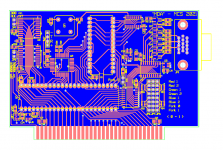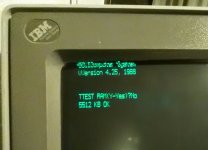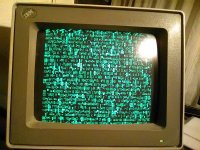I have been experimenting with a home-made graphics (or rather text) adapter. Based on the MDA concept, with a character ROM and a shift register generating the video signal. But I'm trying to generate a VGA-compatible signal - which partly works...
What resolution does standard VGA 80x25 text mode use? My googling tells me either 640x400 or 720x400. I'm using 60x400 currently, using the timing shown here: http://tinyvga.com/vga-timing/640x400@70Hz
The horizontal and vertical sync frequency is correct (tested with a frequency counter), and the sync signals look correct on the scope. But the picture is not quite right. Using either an IBM 8513 or a slightly newer KFC monitor, I get approx what's shown on the photo. The image is too far left, and a bit too high. If my horizontal sync is a bit off, I guess this could move the picture left. But I don't understand the extra height. I'm sure I have the correct number of lines for the vertical sync and front/back porch. Should 640x400 work on a 8513?
The image is actually sharp - the phone camera just wouldn't focus
What resolution does standard VGA 80x25 text mode use? My googling tells me either 640x400 or 720x400. I'm using 60x400 currently, using the timing shown here: http://tinyvga.com/vga-timing/640x400@70Hz
The horizontal and vertical sync frequency is correct (tested with a frequency counter), and the sync signals look correct on the scope. But the picture is not quite right. Using either an IBM 8513 or a slightly newer KFC monitor, I get approx what's shown on the photo. The image is too far left, and a bit too high. If my horizontal sync is a bit off, I guess this could move the picture left. But I don't understand the extra height. I'm sure I have the correct number of lines for the vertical sync and front/back porch. Should 640x400 work on a 8513?
The image is actually sharp - the phone camera just wouldn't focus





